Bezpłatny fragment - The secrets of temperament
Introduction
Sometimes life brings surprises and difficulties. We are constantly surrounded by different kinds of people in different situations, which requires certain behaviour from us. Sometimes we know what to do, but many of these situations can be really difficult. Every day we struggle with work, clients, bosses, colleagues, friends and family by entering into different interactions. All of them affect us as much as we affect them.
Sometimes the situation is really difficult for us, which may mean that it is not compatible with our personality type. If, for example, you do not like public speaking, and your boss requires you to participate in conferences, presentations and trainings, it can cause you a lot of stress and internal tension. Why is it so difficult for you while — as you can clearly see — others are so good at it? The answer is very simple: it’s because of your temperament!
To get to know your temperament you often need to pass an appropriate psychological test, sometimes answering many questions, e.g. „Do you have quick reflexes? Are you well balanced?” How many of us will answer yes? Everyone wants to have quick reflexes and everyone wants to get the best test results! But at the same time we do not want to attribute negative features to ourselves. We will often try to answer “no” to questions like „Do you often act without thinking? Do you speak loudly? Do you often lose your temper?”
We like to see ourselves in good light or focus only on our positive character traits so most of our answers are based on a subjective assessment.
You can make it easier and read the characteristics of each temperament matching yourself to the description you think suits you best. But, again, you will not be sure whether it is true or not since it is still only self-evaluation.
However, I will make it easier for you. From now on, with the help of a small tool — an ordinary pen — you can get to know your true temperament!
This method is much simpler than doing a psychological test. You can easily and successfully do it yourself anytime and anywhere you want. You can present this incredible technique to your loved ones, your friends and workmates! Thanks to this method it will be much easier to find a proper job, a hobby or even a new partner! One look at his or her handwriting is really enough!
You will also understand why some people may be different than you and from now on, your relationships will take on a new dimension!
All you need is a handwriting sample. So get to work!
Chapter 1
Psychological Temperament
Why is temperament so important? Because it has a huge impact on other characteristics. It is an inborn and immutable attribute. It reveals itself as early as in the first year of a person’s life and it forms an individual’s lifelong attitude as well as an unique perception of the world. It is the innate tendency to a stronger or weaker life experiencing or psychic activity. In simple terms: time of reaction. In each of us there are nervous, stimulation and inhibition processes. If they are at the same degree of severity, then we are talking about a balanced type. These innate features of the nervous system affect a person’s individual style of work, daily activities and relationships with other people. On the basis of temperament alone you can determine, for example, what type of work suits you best, who would be a suitable business partner for you or who you can create deeper relationships with. Temperament also defines how we interact with other people and the environment, and what our source of energy is. It determines what increases and what reduces this energy and how we react in difficult situations (i.e. stress). After reading about your temperament, you will understand why a specific situation can be difficult for you and you will also learn the motives that guide the behavior of other people.
Extroversion and Introversion
In Psychology, there is a simple division into two groups. Introverts are Melancholic and Phlegmatic types and Extroverts are Choleric and Sanguine types. Differences between Introversion and Extraversion rely mostly on the tendency to direct action either to the inside or outside. An Introvert directs action into his thoughts and emotions and reduces activity in the outside world. He is usually much taciturn and calmer in his reactions. Introverts avoid conflicts or direct confrontations because their reactions are slower. Similarly, an Extrovert directs his actions outside. He reacts faster with a lot of gesticulation and he speaks at a higher pace. Extroverts will be a little egocentric and talkative, and their activity will be directed to the outside. An Introvert will think: “What is wrong with me?” while the Extrovert will say at the same time: “What is wrong with these people?” The Extrovert rarely has time to reflect on himself. Often, this category of people is also referred to as a dominant type and Introvert as a submissive type. The term “Introvert” is commonly associated with a shy person with inferiority complexes, but shyness or those complexes are acquired features that come from a sense of low self-esteem. Temperament can only increase this feature, which will be more noticeable in the withdrawn Introvert. However, shyness or complexes may also apply to the Extrovert, though it is easier for him to “cover them up”.
Temperament was once a subject of Hippocrates’ research. He found some regularities that shape human behaviour and matched them to the four basic fluids in the body. These were: blood, phlegm and black and yellow bile. About 500 years later, another Greek physician, Galen, came to conclusion that the dominance of one of the fluids associated with specific behavioural traits determined our behaviour. On this basis he distinguished the following types of temperament:
— Sanguine (lat. sanguis –blood)
— Choleric (gr. chole — bile)
— Melancholic (gr. mélanos — black + chole — bile)
— Phlegmatic (gr. phlegma — phlegm)
Since then, four types of temperament have been defined in psychology. You can try to match one of them to yourself using the following descriptions.
Note: throughout this book, the word “he” will be used to refer to a person of a certain type of temperament. Please bear in mind that there are people of both genders with all temperament types. All characteristics and descriptions apply to both men and women.
Choleric
He is an excitable, expressive person, showing a tendency to constant dissatisfaction. He is quick to display anger and aggressive behaviour. Even small things can make him angry. He can easily create emotions and his strength means he is a man of „affects”. He does not avoid challenges. On the contrary: he faces them. You can count on him in difficult situations. In relationships with others, he constantly emphasizes his „ego”. His domination need and impatience mean that interactions with him are often complex and difficult. You can enter into a relationship with him on the principle of giving the way to him. Choleric feelings are characterized by durability, and therefore tend to be obstinate and uncompromising. External reactions are consistent with his internal psychic structure: fast, strong, and — at the same time — irregular.
Melancholic
He is characterized by a pessimistic, anxious and rather negative approach to life, himself and everyday affairs. He is inclined to see the negative sides of life. In most cases, he finds himself in a sad mood; he is overcome by fears and worries that fill his psyche and determine his behaviour. A Melancholic likes peace and hates all the noise or crowds. Life for him is a difficult task, which must be lived with seriousness and full responsibility. He suffers from an inferiority complex and every failure brings his self-esteem level down even further. He is very sensitive. His experiences are deep, though they arise slowly. A Melancholic, unfortunately, is not a social person and his mind is not focused enough outside, on other people. He goes into relationships with great difficulty, but he is relatively stable in relations to the people he lives with. He has difficulty in expressing his feelings, although they are strong and deep.
Sanguine
This is a stable type of temperament. Most often, people of a Sanguine type have very optimistic approach to life; they are open to interpersonal relationships. Such a person is a cheerful, positive man (or woman), and he takes life easy. In unpleasant situations he is usually embarrassed and sad, but this unpleasant state of mind quickly passes by. He sees the world in bright colours and he is a sensitive, open and subtle person. His feelings are weak, not too deep and irregular. He is dominated by „flash in the pan” behaviour; he also quickly changes his objects of interest. As far as interpersonal relationships are concerned, on one hand, due to his high adaptability, he is sociable and well-liked, and on the other hand, due to his instability and lack of balance, he causes many problems. A Sanguine expresses his feelings in an exaggerated way, which causes other people to have a false opinion about the real strength of his feelings.
Phlegmatic
He is characterized by a temperament representing a strong, balanced and inert nervous system (according to Pavlov’s theory). Such people are often well educated and their lives are guided by reason and intellect. In addition, a Phlegmatic is a cheerful, patient and quiet person. If he is not in particularly unfavourable conditions, he is satisfied with the world and with himself. It is difficult to capture his interest, to fascinate him with something, and only a very strong stimulus situation can put him out off balance. Exact stability is his main feature. It is thanks to his imperturbable „peace of mind” that we often call him „cold-blooded.” It is true that a Phlegmatic can also act under the influence of emotions or desire, but he quickly forgets them and soon regains his usual peace. His emotional experiences are deep, but they are focused on selected people and objects. He is passive, calm, and has a high tolerance of everything and everyone. He does not like changes and new situations. He responds poorly to external stimuli and usually his motor reactions are not very quick.
Chapter 2
Graphological Temperament
If you have already chosen your temperament type as defined by psychology, in this chapter you will see whether the description is consistent with your graphological temperament. Now you will discover which temperament type you really are, based on proper measurements of your… handwriting. There is no possibility to manipulate such results or choose a type. This test rules out the risk of erroneous interpretation or subjective opinion. You will also confirm here whether you have properly chosen your psychological temperament counterpart.
Task 1
Before you start your test, take a clean sheet of paper (preferably A4 format), and your favourite writing instrument (ballpoint pen, pencil, etc.). Write 8 or 10 sentences of any content on this sheet. You can, for example, describe your current mood, the place where you are now, or simply write about your day. Some people write in block capitals (uppercase letters only). For the purposes of this test, use the lowercase letters (all small letters) you learned at school. In your sample, all writing zones must be used (upper, middle and lower) and — as you know — the uppercase letters do not have all of them.
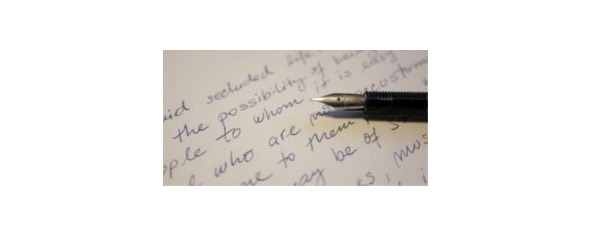
Now look at your writing sample, and search for all the letters that use the upper zone, like: b, d, f, h, k, l, t. Draw a straight line along the vertical elements of these letters. Do it on all of the above letters throughout the sample.

Then underline the words that contain these letters. An angle will be formed between the line of the word and the lean of the letter.
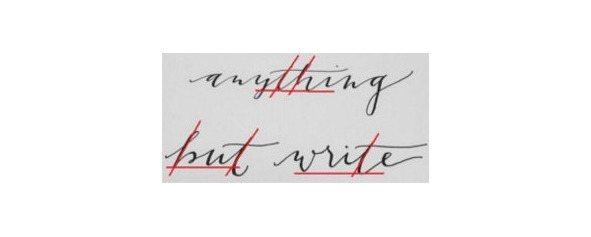
Now, approximately or using a protractor, determine the angle of the letters. Measure them and make note of the angle. We are now going to analyze your handwriting.
If in your handwriting most letters are leaning to the right (between 90 and 75 degrees) you have handwriting described as right slant handwriting; if they lean to the left (between 90 and 105 degrees), you have left slant handwriting, and if they are vertical or close to vertical (no slant, about 90 degrees) it is vertical handwriting.
Now we are going to go through the proper interpretation of your handwriting and determine your temperament.
If your letters are leaning to the right, your temperament is:
Extrovert
His counterpart in psychology is the Choleric. Approximately 55% of the population writes this way (depending on a country of course).
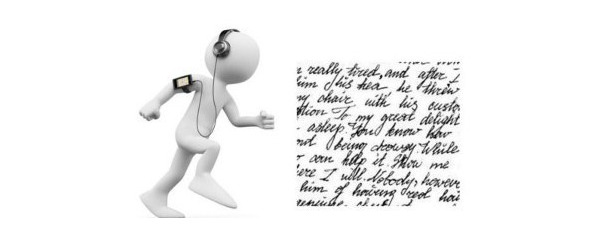
The photo above shows a silhouette of a running person, leaning to the right and, analogously, handwriting leaned to the right. This is a symbol of the Extrovert temperament: energetic, dynamic, boldly walking forward, directed to action and the future. The characteristics apply equally to both: women and men. An Extrovert is a sociable, spontaneous and eager person, always willing to help. He needs to make contact with other people and he is surrounded by many friends. This type wants to be in contact and make conversations. He does not like to spend time alone. He wants to move, change, act and sometimes even take risks. He likes jokes, pranks and always has a ready answer. He is carefree and optimistic about life. He can sometimes be impulsive, even aggressive because he easily loses his self-control. He will often act before thinking. He does not control his feelings too much and he can be changeable and superficial. He has many friends but some of them are deprived of a deeper emotional bond. Typical Extroverts are open to all novelties and have a wide range of interests. Such people see the future in bright colours only and they have big plans. However, they must be careful because very often impulsiveness and emotionality affect their decision making. They also have a strong need for independence and freedom.
The degree of inclination to the right thus indicates the emotions and social expressions of the person writing. The standard is assumed to be within 75 degrees (between 90—75 degrees to be exact). A person with these kind of features is naturally emotional. If the writing is inclined even more to the right (less than 75 degrees), the person has a greater need for affection, and is more emotionally expressive. It is a real emotional volcano!
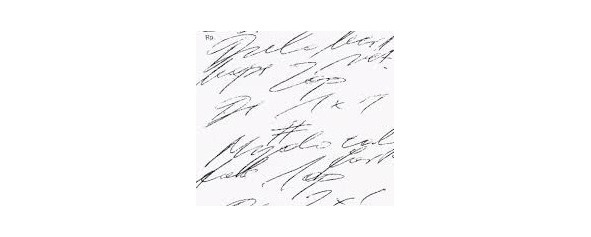
You can now imagine this guy from the photo as he sprints. He will pay less attention to the things he passes along the way. Such a person will have a strong need for action; he will be much faster, more impulsive and more dynamic. And as a result, he will react quickly. He can be jealous and passionate. He can love deeply and hate strongly. However, he loses energy quickly. He can be daring and reckless because his mind does not control his quick actions. He has great sensitivity to sympathies and dislikes, and he strongly receives emotions. It is very easy to provoke him; he can also provoke others easily. Someone whose writing leans so strongly to the right is also submissive to others (partner relations will be described in the following chapters).
We have to be aware that each extremism intensifies the given feature so handwriting with extreme leaning will correspond with increased given characteristics. Thus, an extreme tilt to the right (e.g. 45—30 degrees) will be related to extreme social and emotional behaviour. Such a person is an extreme Extrovert, an emotional storm, who can have extreme mood swings and will often react totally irrationally. He has no control or inhibition. Such individuals have great mental disorders tendency and even fanaticism. They do not care about other people’s opinions. They can even “trample others into the ground” as a manifestation of their self-defence caused by strong ambient pressure. They will feel bad in relationships in the family. If a husband (spouse) is the author of such writing, he may not be the authority figure in his family. The head of the family will be his wife then or this function may even pass to the eldest child. If some other features of handwriting — so-called „cruelty” (sharp and narrow letters) — are added to this kind of writing and strong personality, such people can be even dangerous to others!
If most letters in your sample are clearly leaning to the left (between 90 and 120 degrees) your temperament is:
Introvert
The equivalent in psychology is MELANCHOLIC. This is how about 15% of the population writes.
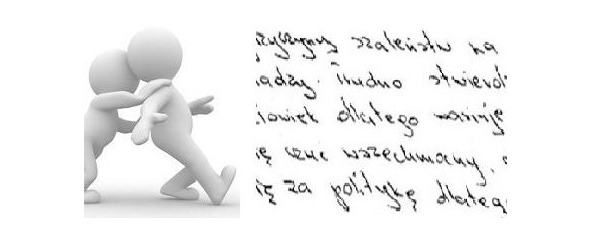
In the picture above, the silhouette of a man leans to the left. It is symbolic and at the same time very meaningful, because such a person is reluctant to step into action. It is often necessary to encourage him or to push him forward. He often prefers to stay in the shadow. He is very careful, aloof, scared and withdrawn. The characteristics apply equally to both women and men. In a typical Introvert, thinking is given precedence over action. He relates to people with detachment and distrust. Sometimes he perceives the environment as hostile and he disbelieves other people. He is not sociable; he needs only a few proven friends. In friendship and love, the Introvert is a faithful and reliable partner. He suffers greatly after losing love and will not be ready for the next relationship for a very long time. He feels his emotions deeply. He has different inhibitions; he withdraws from the world, focusing on himself. He hates crowds. He prefers a book to being with people. He is a cautious, fearful, isolated, closed person. He withdraws from risky situations for fear of emotional trauma. He keeps his reserve in dealing with people, except for family and close friends. He takes everyday life seriously, and he likes it to be organized and ordered. He controls his feelings, rarely behaving aggressively. It’s difficult to get him out of balance. The Introvert is very difficult to recognize because he insulates himself from people, but he can also be very charming in social situations creating an impression of being a very elegant person. It’s hard to believe in his emotional withdrawal. He values high ethics and is rather a pessimist. Quite often his thoughts go back to the past. He might collect souvenirs, stamps, postcards, and photos, and he may be interested in history.
The previously described extreme inclination intensifies the features of the temperament, so if the writing is greatly tilted to the left (up to 120 degrees) this heightens Introversion and all characteristics of this temperament. This can mean a person who is strongly distanced from the environment, completely withdrawn and focused on the past. He focuses only on himself and his feelings. This type can also be mentally addicted to the values imposed by his mother (or a woman in the family). Writing extremely tilted to the left (from 120 to 130 degrees) is very rare. It can be associated with a strong psychological shock and intense fears, often leading to mental disorders.
If your writing stands straight (about 90 degrees) your temperament is:
Ambivert

The counterparts in psychology will be: SANGUINE and PHLEGMATIC. Both of these psychological types can be included in one graphological temperament because they have many common features. As with the others, this characteristic applies to both genders. The silhouette in the picture stands straight since Ambivert means literally „standing straight”. It means stability as well as watching and observing the surroundings. Such a man/woman with an upright posture has, figuratively, a head „higher than the others”, so he basically sees more. He looks at people, phenomena and events. He coolly and calmly analyses situations. Usually, he lives his life in accordance with the applicable laws and rules (balanced — like the Themis of Justice). This is also an example of when the head is higher than the heart, so literally „the mind controls emotions”. He relates to others with respect and distance. This type likes to dominate over people who write letters leaning to the right (which is very important when choosing a partner).
An Ambivert is an intellectual. He stops impulses and controls situations. He is careful, considerate and practical. He takes decisions after deep analysis. He chooses a group of proven and loyal friends. He can also be a bit stiff and cold, but he has good manners. This type creates an impression of a raw, cool person, but he experiences emotions inside without showing them outside. He is restrained in his speech and manner of being. He is more focused on himself and tolerates solitude well. He has magnetic charm and a cool analytical mind, which can be quite attractive. At work, he can be a good manager, leader or boss because of his controlled emotions, his ability to influence others and the need for domination.
The last type of temperament is quite difficult to recognize, because the letters are not inclined to one particular side. They can be leaned both: to the left or to the right. The permissible differences in angles of inclination between the letters are from 5 to 15 degrees, which can indicate mild neurosis or hyperactivity. It is estimated that about 80% of the population has neurosis, because of an overactive lifestyle stress and daily tensions. It is a phenomenon that is quite common and is now considered a „norm”. If the difference in the pitch inclination of the letters is 30 degrees though, it is referred to as neuroticism.
To categorize someone definitively as a neurotic type, we need to analyze the other features of his writing: mostly the size of the letters, the spacing between the lines, words, etc.
Neuroticism is also innate and is characterized by physiological differences in the functioning of the nervous system (hyperactivity of the sympathetic system). So, if in your sample the letters are leaning in different directions, your temperament type is likely to be:
Neurotic

It is not without significance that the picture below shows all the previously mentioned types of temperaments. Each of the silhouettes is heading different direction and performs various activities. In the same way, in the handwriting of a neurotic person, the letters lean in different directions, even sometimes within one word. The appearance resembles a hand fan.
Kup książkę, aby przeczytać do końca.
